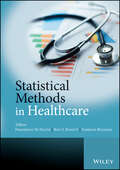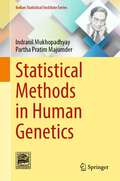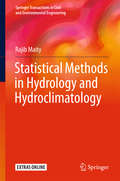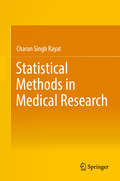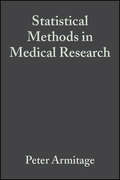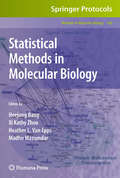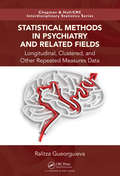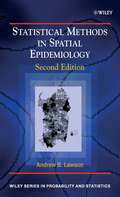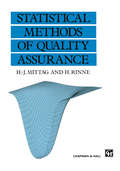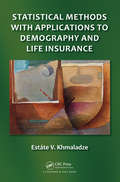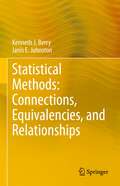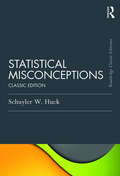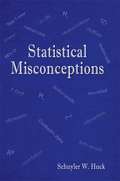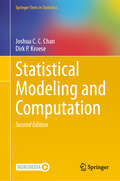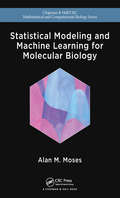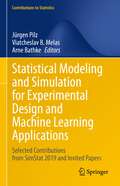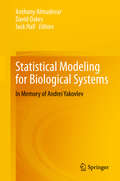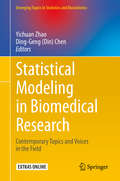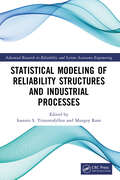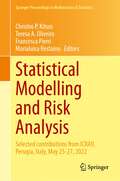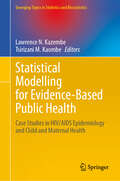- Table View
- List View
Statistical Methods in Healthcare
by Fabrizio Ruggeri Ron Kenett Frederick FaltinIn recent years the number of innovative medicinal products and devices submitted and approved by regulatory bodies has declined dramatically. The medical product development process is no longer able to keep pace with increasing technologies, science and innovations and the goal is to develop new scientific and technical tools and to make product development processes more efficient and effective. Statistical Methods in Healthcare focuses on the application of statistical methodologies to evaluate promising alternatives and to optimize the performance and demonstrate the effectiveness of those that warrant pursuit is critical to success. Statistical methods used in planning, delivering and monitoring health care, as well as selected statistical aspects of the development and/or production of pharmaceuticals and medical devices are also addressed.With a focus on finding solutions to these challenges, this book:Provides a comprehensive, in-depth treatment of statistical methods in healthcare, along with a reference source for practitioners and specialists in health care and drug development.Offers a broad coverage of standards and established methods through leading edge techniques.Uses an integrated, case-study based approach, with focus on applications.Looks at the use of analytical and monitoring schemes to evaluate therapeutic performance.Features the application of modern quality management systems to clinical practice, and to pharmaceutical development and production processes.Addresses the use of modern Statistical methods such as Adaptive Design, Seamless Design, Data Mining, Bayesian networks and Bootstrapping that can be applied to support the challenging new vision.Practitioners in healthcare-related professions, ranging from clinical trials to care delivery to medical device design, as well as statistical researchers in the field, will benefit from this book.
Statistical Methods in Human Genetics (Indian Statistical Institute Series)
by Indranil Mukhopadhyay Partha Pratim MajumderThis book provides an overview of statistical concepts and basic methodology for the study of genetics of human traits and diseases. It attempts to provide a step-by-step description of problem identification, study design, methodology of data collection, data exploration, data summarization and visualization, and more advanced analytical methods for inferring genetic underpinnings of human phenotypes. The book provides codes in R programming language for implementation of most of the statistical methods described, which will enable practitioners to perform analysis of data on their own, without having to mold the data to fit the requirements of commercial statistical packages. Useful to anyone engaged in studies to understand and manage good health, the book is a useful guide for sustainable development of humankind. Primarily intended for practicing biologists especially those who carry out quantitative biological research, in particular, human geneticists, the book is also helpful in classroom teaching.
Statistical Methods in Hydrology and Hydroclimatology (Springer Transactions in Civil and Environmental Engineering)
by Rajib MaityThis book focuses on the application of statistical methods in the field of hydrology and hydroclimatology. Among the latest theories being used in these fields, the book introduces the theory of copulas and its applications in this context. The purpose is to develop an understanding and illustrate the usefulness of the statistical techniques with detailed theory and numerous worked out examples. Apart from this, MATLAB-based codes and solutions of some worked out examples are also provided to assist the readers to handle real life data. This book presents a comprehensive knowledge of statistical techniques combining the basics of probability and the current advances in stochastic hydrology. Besides serving as a textbook for graduate courses on stochastic modeling in hydrology and related disciplines, the book offers valuable resources for researchers and professionals involved in the field of hydrology and climatology.
Statistical Methods in Medical Research
by Charan Singh RayatThis book covers all aspects of statistical methods in detail with applications. It presents solutions to the needs of post-graduate medical students, doctors and basic medical scientists for statistical evaluation of data. In present era, dependency on softwares for statistical analysis is eroding the basic understanding of the statistical methods and their applications. As a result, there are very few basic medical scientists capable of analyzing their research data due to lack of knowledge and ability. This book has been written in systematic way supported by figures and tables for basic understanding of various terms, definitions, formulae and applications of statistical methods with solved examples and graphic presentation of data to create interest in this mathematical science.
Statistical Methods in Medical Research
by Peter Armitage Geoffrey Berry J. N. MatthewsThe explanation and implementation of statistical methods for the medical researcher or statistician remains an integral part of modern medical research. This book explains the use of experimental and analytical biostatistics systems. Its accessible style allows it to be used by the non-mathematician as a fundamental component of successful research. Since the third edition, there have been many developments in statistical techniques. The fourth edition provides the medical statistician with an accessible guide to these techniques and to reflect the extent of their usage in medical research. The new edition takes a much more comprehensive approach to its subject. There has been a radical reorganization of the text to improve the continuity and cohesion of the presentation and to extend the scope by covering many new ideas now being introduced into the analysis of medical research data. The authors have tried to maintain the modest level of mathematical exposition that characterized the earlier editions, essentially confining the mathematics to the statement of algebraic formulae rather than pursuing mathematical proofs. Received the Highly Commended Certificate in the Public Health Category of the 2002 BMA Books Competition.
Statistical Methods in Molecular Biology
by Madhu Mazumdar Heather L. Epps Xi Kathy Zhou Heejung BangWhile there is a wide selection of 'by experts, for experts' books in statistics and molecular biology, there is a distinct need for a book that presents the basic principles of proper statistical analyses and progresses to more advanced statistical methods in response to rapidly developing technologies and methodologies in the field of molecular biology. Statistical Methods in Molecular Biology strives to fill that gap by covering basic and intermediate statistics that are useful for classical molecular biology settings and advanced statistical techniques that can be used to help solve problems commonly encountered in modern molecular biology studies, such as supervised and unsupervised learning, hidden Markov models, methods for manipulation and analysis of high-throughput microarray and proteomic data, and methods for the synthesis of the available evidences. This detailed volume offers molecular biologists a book in a progressive style where basic statistical methods are introduced and gradually elevated to an intermediate level, while providing statisticians knowledge of various biological data generated from the field of molecular biology, the types of questions of interest to molecular biologists, and the state-of-the-art statistical approaches to analyzing the data. As a volume in the highly successful Methods in Molecular BiologyTM series, this work provides the kind of meticulous descriptions and implementation advice for diverse topics that are crucial for getting optimal results. Comprehensive but convenient, Statistical Methods in Molecular Biology will aid students, scientists, and researchers along the pathway from beginning strategies to a deeper understanding of these vital systems of data analysis and interpretation within one concise volume.
Statistical Methods in Psychiatry and Related Fields: Longitudinal, Clustered, and Other Repeated Measures Data (Chapman & Hall/CRC Interdisciplinary Statistics)
by Ralitza GueorguievaData collected in psychiatry and related fields are complex because outcomes are rarely directly observed, there are multiple correlated repeated measures within individuals, there is natural heterogeneity in treatment responses and in other characteristics in the populations. Simple statistical methods do not work well with such data. More advanced statistical methods capture the data complexity better, but are difficult to apply appropriately and correctly by investigators who do not have advanced training in statistics. This book presents, at a non-technical level, several approaches for the analysis of correlated data: mixed models for continuous and categorical outcomes, nonparametric methods for repeated measures and growth mixture models for heterogeneous trajectories over time. Separate chapters are devoted to techniques for multiple comparison correction, analysis in the presence of missing data, adjustment for covariates, assessment of mediator and moderator effects, study design and sample size considerations. The focus is on the assumptions of each method, applicability and interpretation rather than on technical details. Features Provides an overview of intermediate to advanced statistical methods applied to psychiatry. Takes a non-technical approach with mathematical details kept to a minimum. Includes lots of detailed examples from published studies in psychiatry and related fields. Software programs, data sets and output are available on a supplementary website. The intended audience are applied researchers with minimal knowledge of statistics, although the book could also benefit collaborating statisticians. The book, together with the online materials, is a valuable resource aimed at promoting the use of appropriate statistical methods for the analysis of repeated measures data. Ralitza Gueorguieva is a Senior Research Scientist at the Department of Biostatistics, Yale School of Public Health. She has more than 20 years experience in statistical methodology development and collaborations with psychiatrists and other researchers, and is the author of over 130 peer-reviewed publications.
Statistical Methods in Spatial Epidemiology
by Andrew B. LawsonSpatial epidemiology is the description and analysis of the geographical distribution of disease. It is more important now than ever, with modern threats such as bio-terrorism making such analysis even more complex. This second edition of Statistical Methods in Spatial Epidemiology is updated and expanded to offer a complete coverage of the analysis and application of spatial statistical methods. The book is divided into two main sections: Part 1 introduces basic definitions and terminology, along with map construction and some basic models. This is expanded upon in Part II by applying this knowledge to the fundamental problems within spatial epidemiology, such as disease mapping, ecological analysis, disease clustering, bio-terrorism, space-time analysis, surveillance and infectious disease modelling. Provides a comprehensive overview of the main statistical methods used in spatial epidemiology.Updated to include a new emphasis on bio-terrorism and disease surveillance.Emphasizes the importance of space-time modelling and outlines the practical application of the method.Discusses the wide range of software available for analyzing spatial data, including WinBUGS, SaTScan and R, and features an accompanying website hosting related software.Contains numerous data sets, each representing a different approach to the analysis, and provides an insight into various modelling techniques.This text is primarily aimed at medical statisticians, researchers and practitioners from public health and epidemiology. It is also suitable for postgraduate students of statistics and epidemiology, as well professionals working in government agencies.
Statistical Methods of Quality Assurance
by Hans-Joachim. Mittag Horst RinneThis comprehensive textbook is a basic reference which should be recommended to students and teachers in engineering, technology and management as well as to the whole community of professionals already working in quality-related areas.The book aims to be a step-by-step introduction to statistical quality assurance. It has been specifically designed for self-study and includes over 100 fully solved exercises and worked examples. In addition to traditional quality control procedures the book also presents very carefully elaborated results of recent research in order to encourage their adoption into practice.
Statistical Methods with Applications to Demography and Life Insurance
by Estate V. KhmaladzeSuitable for statisticians, mathematicians, actuaries, and students interested in the problems of insurance and analysis of lifetimes, Statistical Methods with Applications to Demography and Life Insurance presents contemporary statistical techniques for analyzing life distributions and life insurance problems. It not only contains traditional material but also incorporates new problems and techniques not discussed in existing actuarial literature.The book mainly focuses on the analysis of an individual life and describes statistical methods based on empirical and related processes. Coverage ranges from analyzing the tails of distributions of lifetimes to modeling population dynamics with migrations. To help readers understand the technical points, the text covers topics such as the Stieltjes, Wiener, and Ito integrals. It also introduces other themes of interest in demography, including mixtures of distributions, analysis of longevity and extreme value theory, and the age structure of a population. In addition, the author discusses net premiums for various insurance policies.Mathematical statements are carefully and clearly formulated and proved while avoiding excessive technicalities as much as possible. The book illustrates how these statements help solve numerous statistical problems. It also includes more than 70 exercises.
Statistical Methods: Connections, Equivalencies, and Relationships
by Kenneth J. Berry Janis E. JohnstonThe primary purpose of this book is to introduce the reader to a wide variety of interesting and useful connections, relationships, and equivalencies between and among conventional and permutation statistical methods. There are approximately 320 statistical connections and relationships described in this book. For each connection or connections the tests are described, the connection is explained, and an example analysis illustrates both the tests and the connection(s). The emphasis is more on demonstrations than on proofs, so little mathematical expertise is assumed. While the book is intended as a stand-alone monograph, it can also be used as a supplement to a standard textbook such as might be used in a second- or third-term course in conventional statistical methods. Students, faculty, and researchers in the social, natural, or hard sciences will find an interesting collection of statistical connections and relationships - some well-known, some more obscure, and some presented here for the first time.
Statistical Misconceptions: Classic Edition (Psychology Press & Routledge Classic Editions)
by Schuyler W. HuckThis engaging book helps readers identify and then discard 52 misconceptions about data and statistical summaries. The focus is on major concepts contained in typical undergraduate and graduate courses in statistics, research methods, or quantitative analysis. Interactive Internet exercises that further promote undoing the misconceptions are found on the book's website. The author’s accessible discussion of each misconception has five parts: The Misconception - a brief description of the misunderstanding Evidence that the Misconception Exists – examples and claimed prevalence Why the Misconception is Dangerous – consequence of having the misunderstanding Undoing the Misconception - how to think correctly about the concept Internet Assignment - an interactive activity to help readers gain a firm grasp of the statistical concept and overcome the misconception. The book's statistical misconceptions are grouped into 12 chapters that match the topics typically taught in introductory/intermediate courses. However, each of the 52 discussions is self-contained, thus allowing the misconceptions to be covered in any order without confusing the reader. Organized and presented in this manner, the book is an ideal supplement for any standard textbook. An ideal supplement for undergraduate and graduate courses in statistics, research methods, or quantitative analysis taught in psychology, education, business, nursing, medicine, and the social sciences. The book also appeals to independent researchers interested in undoing their statistical misconceptions.
Statistical Misconceptions: Classic Edition (Psychology Press And Routledge Classic Editions Ser.)
by Schuyler HuckBrief and inexpensive, this engaging book helps readers identify and then discard 52 misconceptions about data and statistical summaries. The focus is on major concepts contained in typical undergraduate and graduate courses in statistics, research methods, or quantitative analysis. Fun interactive Internet exercises that further promote undoing the misconceptions are found on the book's website. The author’s accessible discussion of each misconception has five parts: The Misconception - a brief description of the misunderstanding Evidence that the Misconception Exists – examples and claimed prevalence Why the Misconception is Dangerous – consequence of having the misunderstanding Undoing the Misconception - how to think correctly about the concept Internet Assignment - an interactive activity to help readers gain a firm grasp of the statistical concept and overcome the misconception. The book's statistical misconceptions are grouped into 12 chapters that match the topics typically taught in introductory/intermediate courses. However, each of the 52 discussions is self-contained, thus allowing the misconceptions to be covered in any order without confusing the reader. Organized and presented in this manner, the book is an ideal supplement for any standard textbook. Statistical Misconceptions is appropriate for courses taught in a variety of disciplines including psychology, medicine, education, nursing, business, and the social sciences. The book also will benefit independent researchers interested in undoing their statistical misconceptions.
Statistical Modeling Using Bayesian Latent Gaussian Models: With Applications in Geophysics and Environmental Sciences
by Birgir HrafnkelssonThis book focuses on the statistical modeling of geophysical and environmental data using Bayesian latent Gaussian models. The structure of these models is described in a thorough introductory chapter, which explains how to construct prior densities for the model parameters, how to infer the parameters using Bayesian computation, and how to use the models to make predictions. The remaining six chapters focus on the application of Bayesian latent Gaussian models to real examples in glaciology, hydrology, engineering seismology, seismology, meteorology and climatology. These examples include: spatial predictions of surface mass balance; the estimation of Antarctica’s contribution to sea-level rise; the estimation of rating curves for the projection of water level to discharge; ground motion models for strong motion; spatial modeling of earthquake magnitudes; weather forecasting based on numerical model forecasts; and extreme value analysis of precipitation on a high-dimensional grid. The book is aimed at graduate students and experts in statistics, geophysics, environmental sciences, engineering, and related fields.
Statistical Modeling and Applications: Multivariate, Heavy-Tailed, Skewed Distributions and Mixture Modeling, Volume 2 (Emerging Topics in Statistics and Biostatistics)
by Ding-Geng Chen Carlos A. CoelhoIn an era defined by the seamless integration of data and sophisticated analytical and modeling techniques, the quest for advanced statistical modeling and methodologies has never been more pertinent. Statistical Modeling and Applications: Multivariate, Heavy-Tailed, Skewed Distributions, Mixture and Neural-Network Modeling, Volume 2, represents a concerted effort to bridge the gap between theoretical advancements and practical applications in the realm of Statistical Science, namely in the area of Statistical Modeling. It also aims to present a wide range of emerging topics in mathematical and statistical modeling written by a group of distinguished researchers from top-tier universities and research institutes to offer broader opportunities in stimulating further collaborations in the areas of mathematics and statistics. The book has eleven chapters, divided in two Parts, with Part I comprising five chapters dealing with the application of Multivariate Analysis techniques and multivariate distributions to a set of different situations, and Part II consisting of six chapters which address the modeling of several interesting phenomena through the use of Heavy-Tailed, Skewed, Circular-Linear and Mixture Distributions, as well as Neural Networks.
Statistical Modeling and Computation
by Dirk P. Kroese Joshua C.C. ChanThis textbook on statistical modeling and statistical inference will assist advanced undergraduate and graduate students. Statistical Modeling and Computation provides a unique introduction to modern Statistics from both classical and Bayesian perspectives. It also offers an integrated treatment of Mathematical Statistics and modern statistical computation, emphasizing statistical modeling, computational techniques, and applications. Each of the three parts will cover topics essential to university courses. Part I covers the fundamentals of probability theory. In Part II, the authors introduce a wide variety of classical models that include, among others, linear regression and ANOVA models. In Part III, the authors address the statistical analysis and computation of various advanced models, such as generalized linear, state-space and Gaussian models. Particular attention is paid to fast Monte Carlo techniques for Bayesian inference on these models. Throughout the book the authors include a large number of illustrative examples and solved problems. The book also features a section with solutions, an appendix that serves as a MATLAB primer, and a mathematical supplement.
Statistical Modeling and Computation (Springer Texts in Statistics)
by Dirk P. Kroese Joshua C. ChanThis book, Statistical Modeling and Computation, provides a unique introduction to modern statistics from both classical and Bayesian perspectives. It also offers an integrated treatment of mathematical statistics and modern statistical computation, emphasizing statistical modeling, computational techniques, and applications. The 2nd edition changes the programming language used in the text from MATLAB to Julia. For all examples with computing components, the authors provide data sets and their own Julia codes. The new edition features numerous full color graphics to illustrate the concepts discussed in the text, and adds three entirely new chapters on a variety of popular topics, including: Regularization and the Lasso regression Bayesian shrinkage methods Nonparametric statistical tests Splines and the Gaussian process regression Joshua C. C. Chan is Professor of Economics, and holds the endowed Olson Chair at Purdue University. He is an elected fellow at the International Association for Applied Econometrics and served as Chair for the Economics, Finance and Business Section of the International Society for Bayesian Analysis from 2020-2022. His research focuses on building new high-dimensional time-series models and developing efficient estimation methods for these models. He has published over 50 papers in peer-reviewed journals, including some top-field journals such as Journal of Econometrics, Journal of the American Statistical Association and Journal of Business and Economic Statistics. Dirk Kroese is Professor of Mathematics and Statistics at the University of Queensland. He is known for his significant contributions to the fields of applied probability, mathematical statistics, machine learning, and Monte Carlo methods. He has published over 140 articles and 7 books. He is a pioneer of the well-known Cross-Entropy (CE) method, which is being used around the world to help solve difficult estimation and optimization problems in science, engineering, and finance. In addition to his scholarly contributions, Dirk Kroese is recognized for his role as an educator and mentor, having supervised and inspired numerous students and researchers.
Statistical Modeling and Machine Learning for Molecular Biology (Chapman & Hall/CRC Computational Biology Series)
by Alan MosesMolecular biologists are performing increasingly large and complicated experiments, but often have little background in data analysis. The book is devoted to teaching the statistical and computational techniques molecular biologists need to analyze their data. It explains the big-picture concepts in data analysis using a wide variety of real-world molecular biological examples such as eQTLs, ortholog identification, motif finding, inference of population structure, protein fold prediction and many more. The book takes a pragmatic approach, focusing on techniques that are based on elegant mathematics yet are the simplest to explain to scientists with little background in computers and statistics.
Statistical Modeling and Simulation for Experimental Design and Machine Learning Applications: Selected Contributions from SimStat 2019 and Invited Papers (Contributions to Statistics)
by Jürgen Pilz Viatcheslav B. Melas Arne BathkeThis volume presents a selection of articles on statistical modeling and simulation, with a focus on different aspects of statistical estimation and testing problems, the design of experiments, reliability and queueing theory, inventory analysis, and the interplay between statistical inference, machine learning methods and related applications. The refereed contributions originate from the 10th International Workshop on Simulation and Statistics, SimStat 2019, which was held in Salzburg, Austria, September 2–6, 2019, and were either presented at the conference or developed afterwards, relating closely to the topics of the workshop. The book is intended for statisticians and Ph.D. students who seek current developments and applications in the field.
Statistical Modeling for Biological Systems: In Memory of Andrei Yakovlev
by David Oakes Anthony Almudevar Jack HallThis book commemorates the scientific contributions of distinguished statistician, Andrei Yakovlev. It reflects upon Dr. Yakovlev’s many research interests including stochastic modeling and the analysis of micro-array data, and throughout the book it emphasizes applications of the theory in biology, medicine and public health. The contributions to this volume are divided into two parts. Part A consists of original research articles, which can be roughly grouped into four thematic areas: (i) branching processes, especially as models for cell kinetics, (ii) multiple testing issues as they arise in the analysis of biologic data, (iii) applications of mathematical models and of new inferential techniques in epidemiology, and (iv) contributions to statistical methodology, with an emphasis on the modeling and analysis of survival time data. Part B consists of methodological research reported as a short communication, ending with some personal reflections on research fields associated with Andrei and on his approach to science. The Appendix contains an abbreviated vitae and a list of Andrei’s publications, complete as far as we know. The contributions in this book are written by Dr. Yakovlev’s collaborators and notable statisticians including former presidents of the Institute of Mathematical Statistics and of the Statistics Section of the AAAS. Dr. Yakovlev’s research appeared in four books and almost 200 scientific papers, in mathematics, statistics, biomathematics and biology journals. Ultimately this book offers a tribute to Dr. Yakovlev’s work and recognizes the legacy of his contributions in the biostatistics community.
Statistical Modeling in Biomedical Research: Contemporary Topics and Voices in the Field (Emerging Topics in Statistics and Biostatistics)
by Ding-Geng Din Chen Yichuan ZhaoThis edited collection discusses the emerging topics in statistical modeling for biomedical research. Leading experts in the frontiers of biostatistics and biomedical research discuss the statistical procedures, useful methods, and their novel applications in biostatistics research. Interdisciplinary in scope, the volume as a whole reflects the latest advances in statistical modeling in biomedical research, identifies impactful new directions, and seeks to drive the field forward. It also fosters the interaction of scholars in the arena, offering great opportunities to stimulate further collaborations. This book will appeal to industry data scientists and statisticians, researchers, and graduate students in biostatistics and biomedical science. It covers topics in:Next generation sequence data analysisDeep learning, precision medicine, and their applicationsLarge scale data analysis and its applicationsBiomedical research and modelingSurvival analysis with complex data structure and its applications.
Statistical Modeling of Reliability Structures and Industrial Processes (ISSN)
by Mangey Ram Ioannis S. TriantafyllouThis reference text introduces advanced topics in the field of reliability engineering, introduces statistical modeling techniques, and probabilistic methods for diverse applications.It comprehensively covers important topics including consecutive-type reliability systems, coherent structures, multi-scale statistical modeling, the performance of reliability structures, big data analytics, prognostics, and health management. It covers real-life applications including optimization of telecommunication networks, complex infrared detecting systems, oil pipeline systems, and vacuum systems in accelerators or spacecraft relay stations. The text will serve as an ideal reference book for graduate students and academic researchers in the fields of industrial engineering, manufacturing science, mathematics, and statistics.
Statistical Modelling and Risk Analysis: Selected contributions from ICRA9, Perugia, Italy, May 25-27, 2022 (Springer Proceedings in Mathematics & Statistics #430)
by Christos P. Kitsos Teresa A. Oliveira Francesca Pierri Marialuisa RestainoThis volume covers the latest results on novel methods in Risk Analysis and assessment, with applications in Biostatistics (which is providing food for thought since the first ICRAs, covering traditional areas of RA, until now), Engineering Reliability, the Environmental Sciences and Economics. The contributions, based on lectures given at the 9th International Conference on Risk Analysis (ICRA 9), at Perugia, Italy, May 2022, detail a wide variety of daily risks, building on ideas presented at previous ICRA conferences. Working within a strong theoretical framework, supporting applications, the material describes a modern extension of the traditional research of the 1980s. This book is intended for graduate students in Mathematics, Statistics, Biology, Toxicology, Medicine, Management, and Economics, as well as quantitative researchers in Risk Analysis.
Statistical Modelling by Exponential Families (Institute of Mathematical Statistics Textbooks #12)
by Rolf SundbergThis book is a readable, digestible introduction to exponential families, encompassing statistical models based on the most useful distributions in statistical theory, including the normal, gamma, binomial, Poisson, and negative binomial. Strongly motivated by applications, it presents the essential theory and then demonstrates the theory's practical potential by connecting it with developments in areas like item response analysis, social network models, conditional independence and latent variable structures, and point process models. Extensions to incomplete data models and generalized linear models are also included. In addition, the author gives a concise account of the philosophy of Per Martin-Löf in order to connect statistical modelling with ideas in statistical physics, including Boltzmann's law. Written for graduate students and researchers with a background in basic statistical inference, the book includes a vast set of examples demonstrating models for applications and exercises embedded within the text as well as at the ends of chapters.
Statistical Modelling for Evidence-Based Public Health: Case Studies in HIV/AIDS Epidemiology and Child and Maternal Health (Emerging Topics in Statistics and Biostatistics)
by Lawrence N. Kazembe Tsirizani M. KaombeThis book presents a selection of statistical techniques and methods applied to analyze data arising from HIV/AIDS epidemiology, as well as child and maternal health. Evidence-based decision-making in public health interventions requires appropriate techniques applied to solve relevant statistical and epidemiological questions, which would, in turn, bring out relevant outputs for action. The different chapters assembled in this book, address various methodological challenges when analyzing HIV/AIDS, child and maternal health data. These include data issues for handling correlated outcomes and repeated measurements generated through longitudinal or follow-up processes, spatial-temporal correlation, measurement error, missingness, co-morbidity, survival analysis, detection of outlying health outcomes, and joint occurrences of outcomes. Essential approaches that enhance statistical science, are presented, when dealing with variable and model selection. Each chapter motivates the problem, provides details of the relevant bio-statistical methods used to tackle the problem, applies the methods to the data, and offers some epidemiological or public health recommendations. Readers can replicate the methods to their data, and R command codes are supplied at the end of each chapter.
